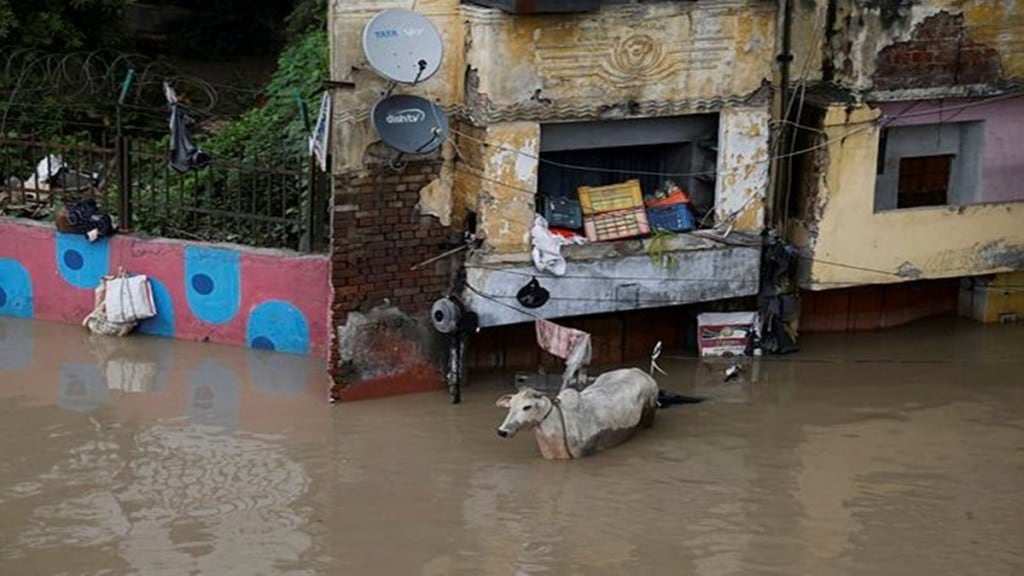A recent study conducted by the Council on Energy, Environment, and Water has unveiled concerning findings about the exposure of India’s population to extreme flood events and the limited coverage provided by early warning systems (EWS). According to the study, approximately 66 per cent of India’s population is exposed to these devastating flood events, while only 33 per cent of those exposed have access to flood EWS.
In contrast, the study highlights the robustness of the cyclone early warning system in the country. It reveals that 100 per cent of people residing in cyclone-prone areas, which constitutes 25 per cent of India’s population, are covered by the cyclone EWS.
Also Read: Delhi Flood News Live Updates
The report, titled “Strengthening India’s Disaster Preparedness with Technology: A Case for Effective Early Warning Systems,” further exposes the weak flood warning system in Himachal Pradesh, one of the states most severely affected by recent heavy rainfall, resulting in numerous casualties and evacuations.
“As India witnesses erratic weather patterns and increasing extreme flood events due to climate change, flood EWS needs to be available to a larger population than earlier,” the report emphasised.
It further stated, “In total, 14 out of 32 states that are exposed to floods, and 9 out of 17 states exposed to cyclones, are highly resilient owing to the availability, accessibility, and effectiveness of EWS and MHEWS. Furthermore, states such as Andhra Pradesh, Odisha, Goa, Karnataka, Kerala, and West Bengal are at the forefront of building resilience by establishing cyclone EWS.”
Also Read: PM Modi calls Amit Shah from France, enquires about flood situation in Delhi
An analysis at the district level reveals that while 72 per cent of districts in India are exposed to extreme flood events, only 25 per cent of these districts have sufficient flood forecasting stations.
Overall, the study highlights that two-thirds of India’s population is exposed to extreme flood events, with only one-third of those individuals having access to flood EWS. The best-performing states in terms of flood EWS availability are Assam, Bihar, Uttar Pradesh, Odisha, and Sikkim, whereas Tamil Nadu, Himachal Pradesh, Karnataka, and Telangana exhibit the lowest availability of flood EWS.
The study finds that 24 out of the 32 flood-exposed states incorporate institutional mechanisms and their roles within the elements of the EWS in their state disaster management plans. However, only six states effectively utilise the allocated funds for establishing flood EWS, including Jharkhand, Tamil Nadu, Assam, Kerala, Himachal Pradesh, and Goa.
The report emphasizes that “Approximately 97.51 million people in India are exposed to extreme flood events in India, and most districts are exposed to more than one extreme event. This highlights the importance of making EWS available to all in India.”
Moreover, the report said that most of India’s exposed population can access early warning information through a mobile or telephone connection pointing out that the gap then remains in data collection and dissemination of early warnings.
A previous study conducted by CEEW in 2021 revealed that 27 out of 35 Indian states and union territories are now vulnerable to extreme hydro-meteorological disasters, impacting 80 per cent of the country’s population.
Lead author Shreya Wadhawan suggests, “Early warning systems are a low-hanging fruit in disaster preparedness. The central and state governments should also invest in regional real-time flood monitoring microsensors, and collaborate with the private sector to improve these warning systems. Leveraging its position as the G20 presidency, India should promote the agenda of making early warnings available to all and champion impact-based people-centric systems for disaster risk reduction.”
During India’s G20 presidency this year, a working group on disaster risk reduction (DRR) has been established, with EWS remaining one of the key priorities.
While India has taken steps to enhance resilience and invest in early warning systems, the report highlights significant gaps, particularly in providing timely, comprehensible, and actionable warnings to the most isolated and vulnerable groups at the community level.
The report concludes by highlighting the prevalence of weather and extreme climate events globally, accounting for a substantial proportion of disasters, economic losses, and deaths. UN Secretary-General Antonio Guterres unveiled an Executive Action Plan at COP 27, aiming to provide early warnings for all.
This plan, requiring a USD 3.1 billion investment from 2023 to 2027, aims to ensure global access to effective early warning systems, particularly for individuals in Small Island Developing States (SIDS) and Least Developed Countries (LDCs).

